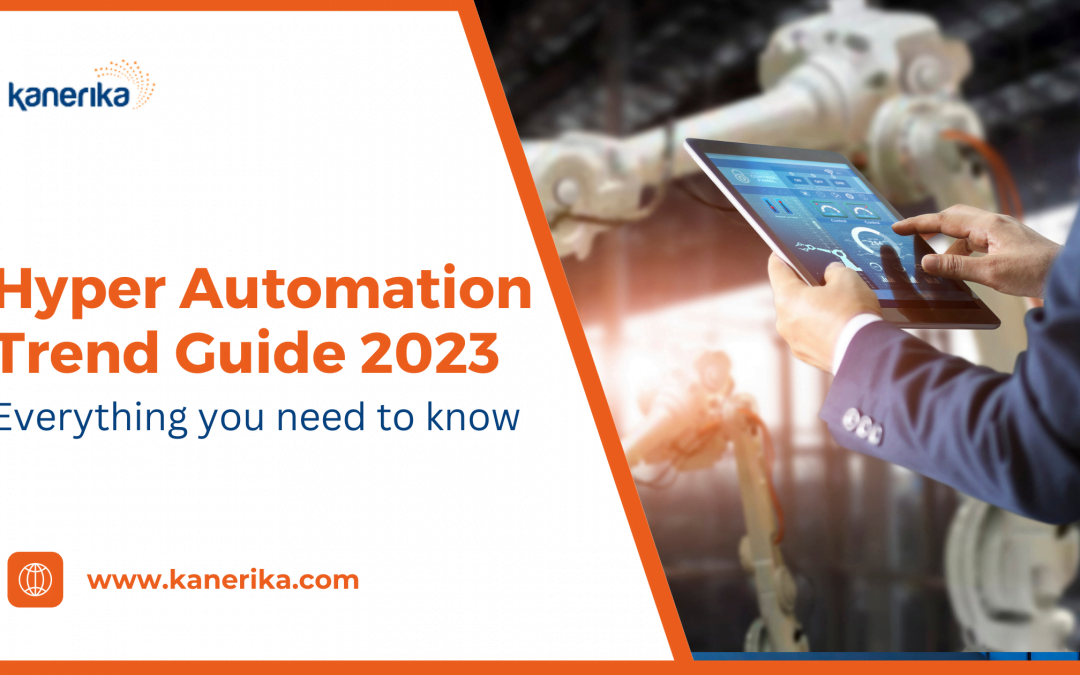Imagine your business operations as an assembly line, where tasks and processes move from one station to the next. In a traditional setup, each station has a specific function, and human workers oversee these tasks.
Now, picture Hyperautomation as a supercharged version of this assembly line. Instead of just human workers, you have advanced machines and robots at each station. These machines don’t just perform basic tasks; they’re equipped with smart technologies like AI, machine learning, and robotic process automation (RPA).
Just like in the assembly line, each machine specializes in a particular task. However, with hyperautomation technologies, they’re not limited to simple, repetitive actions. They’re incredibly intelligent and can adapt to new information or situations.
The result? Tasks move down the line at lightning speed, with minimal need for human intervention. This speeds up production and ensures precision and accuracy in every step.

In essence, hyperautomation turbocharges your business operations, making them faster, smarter, and more efficient than ever before. It’s like upgrading from a regular assembly line to a high-tech, super-efficient production powerhouse. For the same reasons and benefits, the hyper-automation market is forecasted to exceed US$ 155 Billion by 2032, with a projected CAGR of 16.3% from 2023 to 2032.
Still thinking about whether or not to jump on the hyper-automation trend? Keep reading for more clarity on Hyperautomation trends and their role in modern businesses.
What is Hyperautomation?
Hyperautomation is a comprehensive strategy that leverages a combination of technologies to augment human capabilities and automate a wide range of business processes. It goes beyond traditional automation by integrating intelligent technologies like Artificial Intelligence (AI), Machine Learning (ML), Natural Language Processing (NLP), and others, such as…
- Event-driven software architecture
- Business process management (BPM) and intelligent business process management suites (iBPMS)
- Integration platform as a service (iPaaS)
- Low-code/no-code tools
- Packaged software
The combination of these different tools, platforms, and technologies enables businesses to automate routine tasks and complex decision-making processes previously reserved for human intervention.
Kanerika Powered Hyperautomation Case Studies using RPA
Streamlining Freight Audits with Real-Time Contract Visibility
Standardized Data Organization in Insurance systems using RPA
However, the goal of hyper-automation is not to eliminate the need for humans. Instead, automation allows people to devote their time and energy to greater-value activities without dealing with the monotony and low returns associated with routine tasks. By combining the efforts of machines and humans, businesses can better serve their customers, lower their operational expenses, and increase their profits.
Ready to Hyper-automate your business operations, but don’t know where to start? Book a Free Consultation with Kanerika Today!
What are the benefits of Hyperautomation?
Enhanced Efficiency and Productivity
Hyperautomation technology streamlines operations by automating routine, manual tasks across various departments. This includes data entry, document processing, customer support, and more. Employees can focus on higher-value activities by offloading these tasks to automated systems. This leads to increased productivity, as employees can dedicate their time and expertise to jobs that require human intuition, creativity, and decision-making.

Hyperautomation reduces the need for manual labor in repetitive and time-consuming tasks. This translates to significant cost savings over time, especially in industries with labor-intensive processes. With fewer resources allocated to routine tasks, organizations can reallocate their budget towards strategic initiatives, innovation, and growth.
Error Reduction and Increased Accuracy
Automation minimizes the risk of human error in tasks like data analysis, calculations, and processing. This leads to more reliable and consistent outcomes. By eliminating manual errors, businesses can maintain data accuracy and integrity, which is crucial for decision-making, compliance, and customer satisfaction.
Faster Decision-Making and Response Times
Hyperautomation enables real-time data processing and analysis. This allows businesses to make decisions faster and respond swiftly to customer inquiries or market changes. For example, automated analytics tools can process large datasets and provide actionable insights in a fraction of the time it would take manually.
Improved Customer Experience and Personalization:
Automation technologies like chatbots and customer relationship management (CRM) systems enhance the customer experience. Chatbots provide instant responses to customer inquiries, ensuring 24/7 availability.
Additionally, hyperautomation leverages data analytics to create personalized customer interactions. Businesses can segment their customer base and tailor marketing campaigns, product recommendations, and support interactions based on individual preferences and behavior.
Though convenient, automation still necessitates careful preparation and execution. It is important for businesses to plan for the integration of digital technologies in both their current and future processes. Adding automation to a broken process or a process that hasn’t been properly evaluated for its potential for automation can have far-reaching effects on an organization. Integration is a key feature of hyperautomation. Scalability in operations is only possible with the help of complementary automation tools.
Read More: 10 Ways AI & RPA Are Shaping The Future of Automation
Hyperautomation Examples in Business Operations
Streamlining Operational Workflows
Incorporating hyperautomation into day-to-day business operations can yield remarkable results. Consider a customer support system, for example. With hyperautomation, routine inquiries can be handled by chatbots powered by AI and NLP.
These bots can provide instant responses, freeing human agents to focus on more complex and nuanced customer issues. Additionally, hyperautomation can analyze customer data in real-time to identify patterns and preferences, enabling businesses to deliver personalized experiences at scale.
Enhancing Data Processing and Analysis
Hyperautomation plays a pivotal role in data management. Tedious tasks like data entry, validation, and cleansing can be seamlessly automated using RPA. Furthermore, machine learning algorithms can sift through vast datasets to extract meaningful insights, allowing businesses to make data-driven decisions swiftly. This accelerates the decision-making process and enhances the accuracy and reliability of the outcomes.
Optimizing Supply Chain Management
Hyper Automation proves to be a game-changer in supply chain operations as well. From real-time monitoring of inventory levels to triggering automatic reorders when the stock falls below a predefined threshold. There’s a wide scope of processes that can be streamlined using hyperautomation trends. Additionally, it can dynamically adjust production schedules based on market demand forecasts, reducing excess inventory and minimizing carrying costs.
Also Read: Exploring Top 5 Hyperautomation Use Cases
Enabling Predictive Maintenance
Talking about hyperautomation’s role in industries reliant on machinery and equipment? Well, hyperautomation can revolutionize maintenance processes. By leveraging IoT sensors and predictive analytics, businesses can anticipate equipment failures before they occur. This enables proactive maintenance, minimizing downtime and ensuring uninterrupted operations.

Hyperautomation Workflow
Top Hyperautomation Use-cases
Hyperautomation in Healthcare
Hyperautomation in healthcare leverages advanced technologies to revolutionize the industry. It streamlines administrative tasks, enhances patient engagement through virtual assistants, and optimizes electronic health records.
Additionally, it enables personalized treatment plans, assists in medical image analysis, and employs predictive analytics for preventive care. Hyperautomation also manages inventory, facilitates remote patient monitoring, ensures compliance with regulations, and expedites clinical trials.
By combining technology with medical expertise, hyperautomation transforms healthcare processes, leading to improved patient care, streamlined operations, and more informed decision-making.
Hyperautomation in Retail
Hyperautomation is reshaping the retail landscape through advanced technology integration. It enables dynamic inventory management with real-time tracking and automatic reordering. Personalized customer experiences are enhanced through AI-driven marketing and responsive chatbots.
Hyperautomation also bolsters security measures and streamlines e-commerce operations. It revolutionizes supply chain operations, pricing strategies, and customer satisfaction. Predictive demand forecasting anticipates consumer needs and intelligent visual merchandising has great potential to refine in-store experiences.
Hyperautomation in Recruitment
RPA can handle roughly 80% to 85% of recruitment tasks, including interview scheduling, resume screening, onboarding emails, assessments, and performance evaluations. This cost-effective investment reduces the necessity for HR workforce expansion, particularly in expanding markets. For example, Chatbots engage candidates, granting HR teams more time for strategic decision-making. Additionally, data analytics fine-tune talent pipelines, improving hiring precision and speed.
Hyperautomation in Financial Services
Hyperautomation leverages AI, RPA, and data analytics in the financial sector to enhance processes like KYC compliance, fraud detection, and loan underwriting. It optimizes transactional workflows, ensuring accuracy and compliance, while predictive analytics fine-tuning investment strategies improving client outcomes.
Hyperautomation in Sales
Hyperautomation transforms sales operations through AI-powered lead scoring, chatbots for instant customer interactions, and automated follow-ups. It optimizes CRM systems, enabling personalized customer journeys. Predictive analytics and dynamic pricing strategies enhance sales strategies, boosting revenue and customer satisfaction.
Hyperautomation in Industrial
Hyperautomation utilizes IoT sensors and AI for predictive maintenance in the industrial sector, reducing downtime. RPA streamlines supply chain management, optimizing inventory levels and procurement. Automation in production processes enhances efficiency and quality control, ultimately driving operational excellence.
How can Kanerika help you spearhead hyper-automation?
Hyperautomation is not just a trend that comes and goes – it’s a paradigm shift in how businesses operate. By harnessing the full potential of intelligent automation technologies, organizations can unlock new levels of efficiency, agility, and innovation.
Kanerika’s decade of experience in automation, robotics, and artificial intelligence will help you get started with hyper-automation with low-investment and highly tailored solutions.
Join the ranks of over 500 businesses that have redefined success with our custom-tailored solutions, cutting costs and supercharging performance. Don’t let opportunities slip through the cracks of manual work.
Seize them today – connect with our experts and infuse your operations with the power of intelligent processes!












